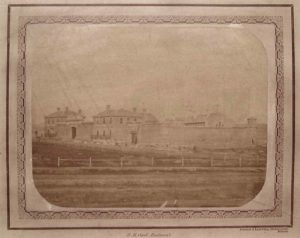The last execution at Ballarat Gaol took place on 29 June 1908. The prisoner Charles Henry Deutschmann, replied “No Sir” when he was asked if he had anything to say. After a little pause he added “I have nothing to say”, concluding, after another slight pause, “Goodbye, God Forgive Me, Goodbye”. Death came within a matter of moments. Deutschmann had brutally murdered his wife, Isabella Jane (nee Collie) shooting both her and her father in April 1908 at Dobies near Ararat, Victoria.
Between 1864 and 1908 at least twelve men met their deaths at the Ballarat Gaol, the first taking place on 29 February 1864.
Gaols sprang up in Victoria as a result of the report of the Select Committee on Prison Discipline of September 1857. They followed the architectural principles put forward by Jeremy Bentham, who based his model on a central viewpoint, with wings of cells radiating outwards. London’s Pentonville Prison was based on his principles. The concept catered for the ease of surveillance of cells and thus the better management of prisoners. One or two guards were able to survey the entire complex from a central position.
The building of the Ballarat Gaol started around 1856 and was completed in early 1862 at a cost of between ₤40,000 and ₤50,000. Locally quarried basalt combined with local bricks were used for the construction.
The community within its walls was almost self sufficient. Gardens adorned the south side of the complex where, as late as the 1950s, prisoners could be seen working. Meals were varied and full use was made of the vegetable gardens. It was reported the gaol had the most modern kitchen in all country Victorian gaols. This was because of the large Agar cooking range as well as other innovative items such as a commercial refrigerator, the electric mincer, and stainless steel sink.
The gaol was closed in 1965 to allow for the expansion of the Ballarat School of Mines which is now part of the University of Ballarat Complex. The gates and wall were restored in 1972 and 1974 and in 1981 the SMB Amenities building was opened. The entrance incorporated the gaol gates, and the building included the former warden’s residence and former governor’s residence. The gaol features in Ballarat Ghost Tours. It is sometimes reported that strange noises and happenings occur in the vicinity of the gaol and its walls, perhaps the murmurings of those souls still within its confines!
Photograph (right) Ballarat Gaol, State Library of Victoria
